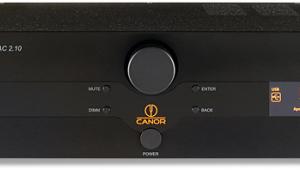Ferrum Audio Wandla USB DAC/Preamplifier Filter Frenzy
The Wandla may be equipped with ESS's ever-popular Sabre ES9038PRO DAC but its implementation here is tied to a separate ARM processor loaded with two sets of alternative digital filter coefficients. By default, the ESS9038 and ESS9028 DACs include a selection of seven pre-programmed linear phase, minimum phase, hybrid, apodising, and brickwall filter options. Ferrum has chosen three of these – the apodising and fast roll-off linear and minimum phase options [blue, orange and green impulse and HF responses, respectively, illustrated on the inset Graph]. ESS's apodising filter shows its characteristic ±0.05dB response ripple but offers a full 87dB stopband rejection while the 'fast' linear and minimum phase options show pre/post and post-event ringing, respectively, and offer the flattest –0.14dB/20kHz, –0.7dB/45kHz and –1.9dB/90kHz responses with 48kHz, 96kHz and 192kHz media. Stopband rejection is 82dB (lin phase) and 74dB (min phase).

The other two filters are Ferrum's own (in collaboration with HQPlayer) and supersede the custom slow roll-off minimum phase filter that was trialled in the ERCO DAC/headphone amp [HFN May '22]. These new 32-bit filters are dubbed 'Gaussian' and 'Apodising' and both have very similar linear phase characteristics [black and red impulses/responses, respectively]. They offer an almost complete 124dB stopband rejection and are only really distinguishable at the extreme edge of the pass- and transition bands where the Gaussian filter cuts away to –0.2dB/19.6kHz and –0.5dB/20kHz and the Apodising to –0.2dB/19kHz and –0.8dB/20kHz with CD media. With high rate 192kHz sources the filters roll-off more gently to –16.1dB and –16.5dB/90kHz, respectively. PM

























































